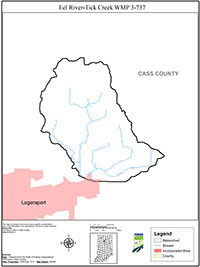Summary
The Eel River-Tick Creek watershed encompasses approximately 9,011 acres immediately northeast of Logansport, Indiana and lies at the downstream end of the larger Eel River basin in Cass County, Indiana. The watershed contains four main streams, Laird Ditch, Tick Creek, Shackelford Ditch, and Howard Ditch, one river, the Eel River, and one private, manmade lake, Lake Perry. With funding from the U. S. Environmental Protection Agency through the Indiana Department of Environmental Management’s Section 319 grant program the Lake Perry Estates Corporation (LPEC) and the Cass County Soil and Water Conservation District (SWCD) initiated the development of a watershed management plan (WMP) in an effort to improve water quality in the lake and streams in the Eel River-Tick Creek watershed.
The LPEC and Cass County SWCD, along with their consultant, held several public meetings, reviewed available historical water quality data, and conducted current water quality sampling to identify water quality concerns in the Eel River-Tick Creek watershed. Through the use of public notices and targeted mailings, all property owners in the watershed as well as representatives from local, state, and federal natural resource agencies, not-for-profit organizations, and local governments were invited to attend the public meetings. Several common themes began to surface during the public meetings. The three concerns emerged as the top concerns of the watershed stakeholders: 1. the streams and lake did not support multiple uses such as water quality, biological habitat, and aesthetic value; 2. water from the Eel River-Tick Creek watershed flows into the Eel River, which is the water source for the City of Logansport; and 3. watershed stakeholders do not understand the actions they could take to protect water quality.
As a first step toward addressing their three top concerns, the watershed stakeholders agreed on the vision statement: The Eel River-Tick Creek watershed and its water bodies are clean, stable, and treasured resources, where improved water quality supports recreation, agriculture, land-drainage, aquatic life and potable water - resource preserved and strengthened through Cass County resident’s civic pride, knowledge and stewardship.
Watershed stakeholders, along with the consultant, also identified the stressors associated with the top concerns and their sources. High nutrient and sediment loads reaching the streams and lake are the primary stressors driving the eutrophication of the waterbodies. The secondary stressor identified by watershed stakeholders was lack of knowledge by property owners living in and around the watershed. Pathogenic contamination, as evidenced by high E. coli concentrations, was another stressor identified by watershed stakeholders.
To reduce the identified stressors in the Eel River-Tick Creek watershed and address to other concerns identified by watershed stakeholders, the stakeholders developed six goals and developed an action plan for each of the goals. The goals in order of priority as agreed upon by the watershed stakeholders are as follows:
- Goal 1: We want to increase participation by all stakeholders including local natural resources agencies/representatives, possibly resulting in the formation of a watershed group.
- Goal 2: Within two years, each landowner within the watershed will learn and implement at least one water quality improvement practice/technique on his/her own property.
- Goal 3: We want to reduce the sediment load to the waterbodies within the Eel River-Tick Creek watershed by 50% over the next five years.
- Goal 4: We want to repair and maintain existing drainage tiles to ensure property owners have full use of their land.
- Goal 5: We want to reduce the nutrient load reaching Lake Perry by 50% over the next 10 years.
- Goal 6: We want to reduce the concentration of E. coli within the waterbodies in the Eel River-Tick Creek watershed so that water within the streams and lake meets the state standard for E. coli within 10 years.
Where feasible, the goals list specific targets watershed stakeholders wish to reach. Additionally, the plan identifies who will assist with completing the plan and indicates what measures will be used to identify successful achievement of the plan’s goals and objectives.

